Aden Park and Farming Museum
Incorporating
a Doo-cot, 1 mile west of Mintlaw, forest walks, pond and great playpark for
the kids. |
 |
Archeolink
Archeolink is a multi-award winning history park
and visitor attraction which focuses on 'education, participation and
fun'. Travel 10,000 years back in time and visit the exhibits, which
include an Iron age farm and hill fort, Roman marching camp, stone age camp,
the sand pit, the henge, stone circle, bronze age smithy and cist. Situated
in the beautiful countryside on the north side of Bennachie. |
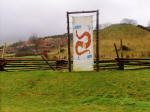 |
Auchindoon
Castle
In the 1470's Auchindoon was built, probably by master mason Thomas
Cochrane. According to an information panel at the castle -
In 1509 Sir James Ogilvy of Deskford grants the
Mains of Auchindoon with its castle, fortalice and Castle Hill to his nephew
Alexander Ogilvy.
In 1567 the castle was sold to Sir Adam Gordon.
In 1571 a party of Gordon's from Auchindoon
Castle attacks and burns Corgaff Castle along with its occupants.
In 1594 it was sold back to the Ogilvy's.
In 1660 Auchindoon was granted to the Marquis of
Huntly.
In 1724 the castle lies derelict, William Duff
of Braco is granted permission to remove stones for his new house at
Balvenie.
Today it is maintained by Historic Scotland.
Our thanks to Stan Bruce for the info and picture. |
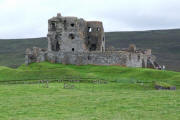
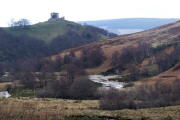 |
Balvenie Castle
At Dufftown on the A941.
Tel: 01340 820121.
A fine 13th-century castle of enclosure with a curtain wall, first owned by the Comyns.
Balvenie was added to in the 15th and 16th centuries. Visited by Mary Queen of Scots in
1562.
Winter: closed. |
 |
Bow Fiddle Rock
The impressive 'Bow Fiddle Rock' situated
on the coast at Portnockie NJ495688 |
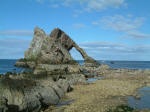 |
Boyne Castle
Standing hidden away in the trees is this crumbling ruin, a wonderful piece
of architecture which has been neglected since the 18th Century.
Approx 5 miles west of Banff. |
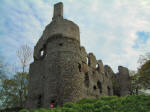 |
Brandsbutt Symbol Stone
About one mile north west of Inverurie, 38 NJ 759 224
An early Pictish symbol stone, with an ogham inscription.
Picture by Duncan Fenton |
 |
| Brodie Castle |
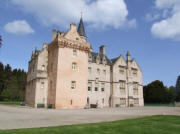 |
|
Bruce's
Seat
which formerly stood on Barra Hill, but now sited on the outskirts of
Oldmeldrum very near the roundabout to the Inverurie road. It is said
that Bruce sat here during the Battle of Barra (Otherwise known as the
Battle of Inverurie) when his army beat Comyn Earl of Buchan in 1308.
Our thanks to Stan Bruce for the info and this picture.
|
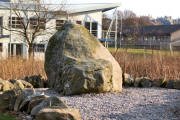 |
Burghead Well
In King Street, Burghead
A rock-cut well, identified by some as an early Christian baptistry associated with
the local cult of St Ethan. |
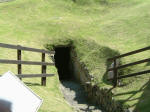 |
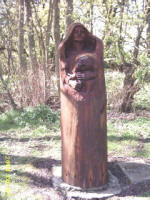 Colleonard
Sculpture Garden Colleonard
Sculpture Garden
1 mile south of Banff on the A97
Free entry to garden & Gallery by Frank Bruce.
(Now closed) |
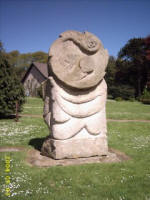 |
Corgarff Castle
8m W of Strathdon on the A939, 37 NJ 254 086
Tel: 01975 651460
A 16th-century tower house converted for use as a barracks for Hanoverian troops after
Culloden. Its last military use was as a base to control the smuggling of illicit whisky
in the early 19th century. Still complete with star-shaped fortifications; reconstructed
whisky still and barrack room.
Winter:closed |
 |
Cullerlie Stone Circle
Near Echt, 12 miles west of Aberdeen, 38 NJ 786 042
A circle of eight stones enclosing an area consecrated by fires on which eight small
cairns were later built. About 4,000 years old.
The link on the page to the streetmap shows you the wrong location it is
a couple of miles to the east of this.
Bronze Age Sepulchral stone circle consisting of eight stones and within
this are eight cairns date 1800-1200 BC.
|
 |
Culsh Earth-House
At Culsh, one mile east of Tarland, 37 NJ 504 054
A well preserved underground passage, with roofing slabs intact over the large
chamber and entrance. About 2,000 years old.
This
souterrain, or underground store-house is basically a hole dug in the
ground lined with dry-stone with a roof made with stone slabs. Take a
torch if you intend to visit, otherwise you won't see anything. Used as a
pre-historic larder or fridge, probably built in the 1st millenium A.D.
(Stan Bruce Oct 2005).
|
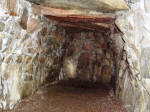
 |
Delgatie Castle
Just of the A947, 10 miles south of Banff
The castle is situated two miles east of Turriff.
There is thought to have been a castle at Delgatie from around 1050.
Delgatie was once a stronghold of the Comyn Earls of Buchan but was given to
Hay, Earl of Erroll, High Constable of Scotland by Robert the Bruce after
the ‘Battle of Bannockburn’ in 1314. The castle was re-built in 1570. The
castle has two rooms with fine painted ceilings of renaissance fantasy dated
1592 and 1597; strange animals are depicted with human heads. Extended in
the 16th and 17th centuries. The castle is open to
visitors during the summer season. A famous ballad was written near here -
'The Barnyards o' Delgatie'. (S. Bruce Jan 2008). |
 |
Dallas Dhu Distillery
1m S of Forres off the A940.
Tel: 01309 676548.
A completely preserved time capsule of the distiller's craft built in 1898. Wander at will
through this fine old Victorian distillery then enjoy a dram. Visitor centre, shop and
audio-visual theatre.
Winter: closed Thursday afternoons and Fridays. |
 |
Deer Abbey
Near Old Deer, 10 miles west of Peterhead, 30 NJ 968 481
The remains of a Cistercian monastry founded in 1219
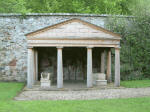
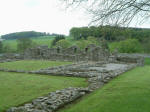
|
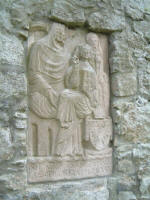 |
Deskford Church
Four miles south of Cullen, 29 NJ 509 616
The ruin of a small late medieval church with a rcihly carved sacrament house of a
type characteristic of north east Scotland. |
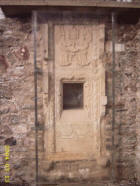 |
Deveron Bridge
The bridge at Banff was designed by
Smeaton and built in 1779 for the 2nd Earl of Fife. The first
bridge was built here in 1765 but was swept away in a storm. Prior to the
bridges the Deveron was crossed further up river at the
Kings Ford. |
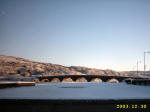 |
Drinnies Observatory
2 mile north
of Mintlaw Drinnies forest walks and Drinnies Observatory, find out the
History of the Pitfour Estate. The Observatory was originally built to
overlook the Lairds horse racing race track. Theres also a stone circle
nearby.The Observatory was
built in 1845 by Admiral George Ferguson 5th Laird of Pitfour (Near
Mintlaw, Buchan) The Octagonal tower gives outstanding views over Buchan
and is thought to have been built by the Laird so he could watch his
horses being run on his very own race track. The Observatory was
refurbished in 1993 and the Forest of Deer walks and the Observatory are
both free to enter. The top of the tower has historical information on
the Pitfour Estate.
|
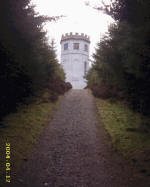

|
Duff House
On the outskirts of Banff, 29 NJ 690 633
Tel: 01261 818181
A magnificent early Georgian mansion, designed by William Adam for Earl Fife and
acknowledged to be his masterpiece. Now open as a Country House Gallery of the National
Galleries of Scotland.
Open all summer from 10.00am to 5.00pm. Open Thursday to Sunday in winter 10.00am to
5.00pm.
Built in 1740 for the 1st Earl of Fife, was never completed to the original
grand design which included east and west wings. The house as it stands was
completed in 1754 by the 2nd Earl of Fife. Was used as a prisoner of war
camp in world war two, has been a hotel and also a sanotarium. |
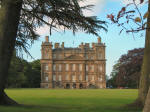 |
Duffus Castle
Five miles north west of Elgin, 28 NJ 189 672
One of the finest examples of a motte and bailey castle in the north of Scotland and
the original seat of the Moray family. (Thanks to Tam Fairley for the
picture) |
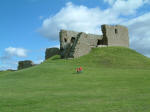 |
Dunideer Hill Fort
Near Insch, once an impressive Pictish
hill fort settlement circa 1000BC and the Castle (Circ 1260) previous home
of the Tyrie (Tyree) family up to the 18th century, sitting on the hill
876ft high. |
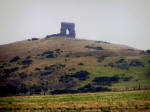 |
Dunnottar Castle
2 miles south of Stonehaven, east of A92 NO 882839
Group of several buildings ranging from 12th to 17th C.
(Stan Bruce July 2009). |
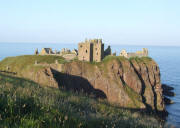 |
Dunnotter Church
The first Dunnottar Church was built in the fifth century and stood where
Dunnottar Castle now stands. A second church dedicated to St Ninian was
built on the promontory in 1276. In 1297 William Wallace burned it down
with a garrison of English soldiers. Sir William Keith Earl Marischal built
the first Dunnottar Church in its present location in 1394 said to be a
sanctuary away from the constant hostilities around the castle. The church
was rebuilt in 1593 then replaced with a much larger building in 1782. It
was added to in 1869 and in 1903 it was completely restored and extended to
the structure we see today.
Adjacent to the church is the
'Marischal Aisle' on the wall is a plauqe which is inscribed as follows:
“This building first erected in 1582 was restored by the University of
Aberdeen in 1913. It covers the last resting place of George Keith 5th
Earl Marischal. He founded Marischal College in Aberdeen in 1593 and is
interred here along with other members of his famous house. The hoarse sea
winds and caverns of Dunnottar singing vague requiem to his honourable line
and him in the imaginations of some few.” The aisle was built by George
Keith 5th Earl as a family burial place. George Keith 5th
Earl Marischal had ‘Old Stonehaven’ created as a burgh of barony in 1624, he
also had Peterhead earlier created as a royal burgh in 1593.
To the rear of the Marischal Aisle is the
‘Covenanters’ Stone’ or ‘Martyrs Stone’ a memorial to the Covenanters’ 122
men and 45 women who where cruelly imprisoned in the ‘Whigs Vault’ of
Dunnottar castle in 1685 and died as a result of the imprisonment. (The
stone was repaired by Robert Paterson in 1796). The stone reads:
HERE LYES JOHN STOT ATCHISON JAMES RUSSELL &
WILLIAM BROUN AND ONE WHOSE NAME WEE HAVE NOT GOTTEN AND TWO WOMEN WHOSE
NAMES ALSO WEE KNOW NOT AND TWO WHO PERISHED COMING DOUNE THE ROCK ONE WHOSE
NAME WAS JAMES WATSON THE OTHER NOT KNOWN WHO ALL DIED PRISONERS IN
DUNNOTTAR CASTLE ANNO 1685 FOR THEIR ADHERENCE TO THE WORD OF GOD AND
SCOTLAND’S COVENANTED WORK OF REFORMATION REV JJ CH J2 VERSE.
The missing names are John White, William
Breadie, Marie Gipsone and Jeane Muffet. (S. Bruce Jan 2008). |
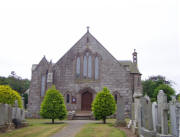
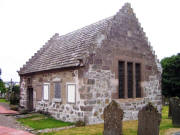
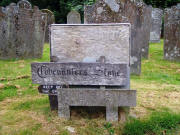
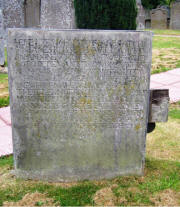
Stoney
A poem about the Stone |
Duthie Park
Duthie Park was donated to the City
of Aberdeen by Elizabeth Crombie Duthie and was officially opened by HRH
Princess Beatrice in 27 Sept 1883. The park consists of Winter Gardens,
Victorian Bandstand, monuments, boating pond etc
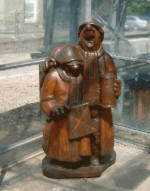
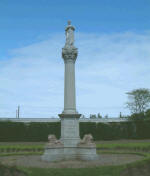

|
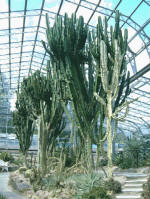
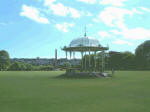 |
Dyce 'Standing
Stones'
(Also known as Tyrebagger Stone Circle) is a recumbent stone circle
approximately 60 feet in diameter, and was erected around 3,000BC. It is
situated high on Tyrebagger Hill at Kirkhill, Dyce, Aberdeen. The two
pillar stones flanking the recumbent stone are an amazing eleven feet and
nine feet five inches high; the other stones vary in height down to as
little as three feet. The photo shows ten upright stones of the eleven
standing. Up here it is so close to the city of Aberdeen yet is is so
peaceful, from here wonderful views can be had, but don't venture up here
unless you have an ordnance survey map. Grid ref NJ 859132. (Stan Bruce Feb
2008). |

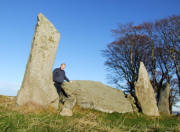 |
Dyce Symbol Stones
Near Dyce, six miles west of Aberdeen, 38 NJ 875 154
In the ruined parish church, two Pictish stones, one with the older type of incised
symbols, and the other with symbols accompanied by a Celtic cross and decoration.
The Dyce symbol
pictish stones are inside the kirk.
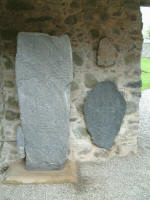
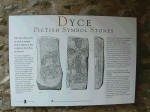 |

|
Dyce Old Kirk
Also known as the 'Chapel of St
Fergus' it is currently roofless although it has been consolidated. It
dates from pre-reformation times and was last in use in 1872. An ancient
(Now broken) baptismal font lies at the doorway to the kirk. The Dyce
symbol stones are housed inside the kirk - photos also shown on this page.
Grid ref NJ875154 (Stan Bruce Feb 2008).
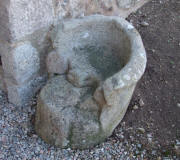 |
 |
Easter Aquhorthies Stone Circle
About one miole west of Inverurie, 38 NJ 732 207
A recumbent stone circle about 4,000 years old.
Picture by Duncan Fenton |
_small.jpg) |
Elgin Cathedral
In Elgin on the A96.
Tel: 01343 547171
The superb remains of a majestic and beautiful 13th-century cathedral. Almost destroyed in
1390 by Alexander Stewart, the infamous "Wolf of Badenoch". You can see the
Bishop's home at Spynie Palace, 2 miles north of the town.
Winter: closed Thursday afternoons and Fridays.
|
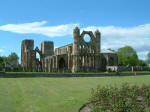 |
|
Elgin Museum
Pictish symbol stones, the Burghead Bull etc Model ships, old
bagpipes etc.
The kids can dress up with the old costumes and use the interactive
computers..
 |
 |
Findlater Castle
and Doocot
10
mile west of Banff sitting on the coast the ruin of a once impressive and
well protected castle.
Built by the Ogilvies in 1455 and abandoned in
the 17th Century when they re-located at Cullen House. Take GREAT CARE if
you venture down to the castle it is a dangerous place.
 |
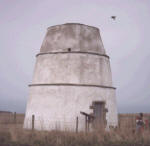 |
Fort Fiddes
Castle Point, Troup, promontory fort sited on 100 feet high cliffs of old
red sandstone, the first settlement here is thought to have been around 200
to 300 BC based on radio carbon dating of pottery found on the site. In the
13th century Norman ‘De Trop’ built a tower house here which was abandoned
in the 17th century. During the unsettled period of the Jacobite
risings (early 18th century) Captain Fiddes built a fort here
which became known as 'Fort Fiddes', it was later abandoned around 1800AD.
On the east side of the promontory is a beach known as 'Cullykhan Beach'
this is thought to have been used by the Picts as a natural harbour, today
it used by locals and some tourists as a great secluded spot for
sun-bathing. From the promontory looking west you can see a large hole in
the hillside this is known as 'Hells Lum' and in certain seastates and bad
weather it looks as if it's smoking. Grid Ref NJ837661. (Stan Bruce Feb
2008). |
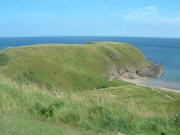
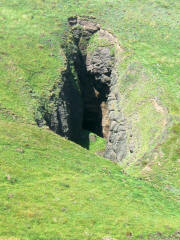 |
Fraserburgh
Heritage Centre
A great collection of Fraserburgh's
(The Broch as it's known locally) heritage. History of the town, the
Fraser's Lord Saltoun. Displays of Thomas Blake Glover, WW2 'Little London'
as Fraserburgh was known due to the great amount of bombing, Fishing and the
fish factories, RNLI, railways, famous Brocher's etc etc not to be missed!
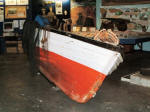
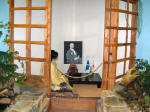
|
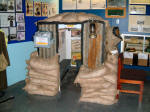
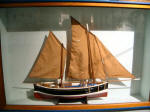 |
Glenbuchat Castle
14 miles west of Alford, 37 NJ 397 148
A fine example of a Z-plan tower house, built in 1590. Its last laird, John Gordon,
was a notable Jacobite.
Picture by Duncan Fenton |
 |
Glover House
Aberdeen
Glover House was originally built as a single storey house in 1815. When
Thomas' father retired from the Coastguard service Glover bought the house
as a retirement home for the family. The House in 79 Balgownie Road, Bridge
of Don, Aberdeen is another piece of the North East's hidden treasure.
Thousands of people drive past this house everyday but have not seen the
secrets this house keeps.
Thomas Blake Glover born in Fraserburgh in 1835 was instrumental in the
building of modern day Japan. He built the first dry-dock in Kosuge, Japan,
he had the first modern warships introduced in Japan (Built in Aberdeen), he
brought the first railway locomotive to Japan and built Japan's first
railway line. He developed the first coal mine, he was instrumental in
developing the first mint, he helped overthrow the Shogun, opened his own
brewery (Now Kirin beer) he even helped form and cut the growth for Japan's
first golf course (1903). This house in Aberdeen was even used to smuggle
out Japanese youth to get educated in the UK, which includes their first
prime minister Hirobumi Ito (1841 - 1909) and much, much more. The house
has been restored thanks mainly to Mitsubishi who donated a considerable sum
in recognition of Glover's contribution toward modern day Japan. The
shipyard Glover opened in Nagasaki later became Mitsubishi. The house
serves as a memorial to Thomas Blake Glover and has many interesting
articles such as the clan chiefs ceremonial armour shown and loads of
Japanese items, swords, china, etc. (Stan Bruce Sep 2005)
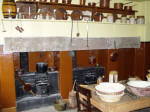
|
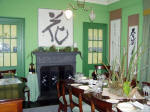
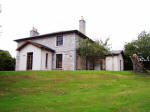
 |
|
Gordon, General Patrick
(1635 to 1699)
Patrick Gordon was born in
Auchleuchries, Aberdeenshire. He was educated at the parish schools of
Cruden and Ellon. At the age of fifteen he left Scotland and enrolled at
the ‘Jesuit College’ in Braunsberg, Prussia. He didn’t like the school and
decided to leave and head back to Scotland, however he never made it back to
Scotland instead enrolling in the Swedish Army (1655). He spent the next
ten years fighting for the Swedes, the Polish and then the Russians. In
1678 the Russian army appointed him as major-general. In
1683 he was promoted to lieutenant-general, and in 1689 he was promoted to
General. He gained great respect and friendship
from the ‘Tsar Peter I’ and later became ‘General-in-chief’ of the Russian
army, he died with the Tsar ‘Peter the Great’ at his bedside in Russia in
1699. General Patrick Gordon’s unmarked memorial cairn can be found ½ mile
from the ‘Halfway House’ just off the A952 heading west, it sits on the top
of a dyke separating two fields. Grid ref NK009360. (S.Bruce Jan 2008). |
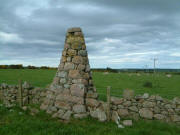 |
Grampian
Transport Museum
Alford
Packed with vintage cars, old motorbikes,trams, old police cars, AA
Memorabilia and there's even a massive old organ from the continent.
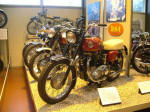
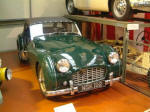
|

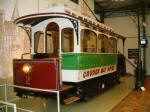 |
Gordon
Highlanders Museum
The museum is located in a greatly extended St Luke's, Viewfield Road,
Aberdeen, once home to Sir George Reid PRSA (1841 to 1913) artist and
president of the Royal Scottish Academy. The museum is home to a large
collection of medals including several Victoria Crosses. There is a small
theatre which gives an introduction to the history of the Gordon
Highlanders. The Grant room exhibition explores the 200 year history, the
Armoury contains a large selection of guns, swords and Gurka knifes.
Regimental silver, crystal and crockery can be seen in the Lakin Room and
some of Sir George Reid's paintings can also be seen. For the kids there's
the opportunity to dress up as a soldier. The facility also has a very nice
cafe which can e used even if you're not entering the museum, well worth a
visit; telephone 01224 311200.
www.gordonhighlanders.com
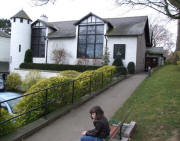 |
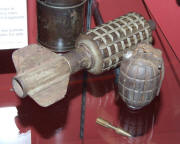
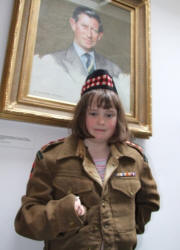 |
Huntly Castle
In Huntly on the A96.
Tel: 01466 793191.
Set in a beautiful wooded riverside setting this fine hall house, built in the 16th and
17th centuries for the Gordon family, is famed for the fine heraldic sculpture and
inscribed stone friezes.
Winter: closed Thursday afternoons and Fridays.
 |
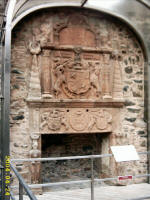 |
Kildrummy Castle
10m SW of Alford on the A97.
Tel: 01975 571331.
Called the "Queen of Highland Castles" this was the stronghold of the Earls of
Mar, and headquarters for organising the 1715 Jacobite Rising by the last Mar owner
"Bobbing John". Scotland's most complete 13th-century castle.
Winter: open weekends only. Picture by
Duncan Fenton |
 |
Kilduthie Monument
- Corrichie Battlefield
This monument is a 12 foot high (3.6m) granite pillar erected in 1951 by the
Deeside Field Club. Corrichie Battlefield lies approx. 4 mile northeast of
Banchory on the southeast slopes of the Hill of Fare. On 28th October 1562,
Mary, Queen of Scots’ (1542 to 1587) army led by James Stuart (1531 to 1570)
Earl of Moray, fought against a much smaller force led by George Gordon
(1514 to 1562) 4th Earl of Huntly. George Gordon’s army was routed and he
was killed. Queen Mary is said to have watched the battle from a granite
crag on Berry Hill thereafter known as the Queen's Chair.
Picture by Stan Bruce
|
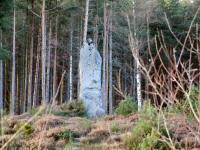 |
Kinloss
Abbey
Founded in 1150AD by King David I for the Cistercian Order initially
probably as a wooden building. The Abbey was badly damaged by fire mid 13th
century and extensively rebuilt c1269 using locally quarried stone. It
maintained powerful religious and secular control over the northeast of
Scotland until its demise in 1560. The Abbey has been a ruin since 1650. To
the south of the Abbey is a second ruin which was once the Bishops House. |
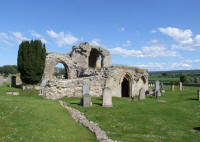
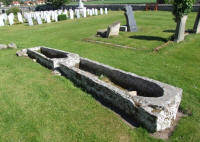 |
Kinneff Church
Near Stonehaven, off A92.
Smuggled out of Dunnottar Castle by Mrs. Grainger, the minister's wife, the
Honours of Scotland - the crown, sword & sceptre - were hidden under the
pulpit to prevent Oliver Cromwell from seizing them in 1652. Most of
present church dates from 1738, but part of old church survives. Contains
monument to Rev. Grainger & Ogilvy, Governor of Dunnottar castle. Honours
lay hidden for 8 years & were brought out in 1660 at the restoration of the
monarchy.

Picture by Duncan Fenton |
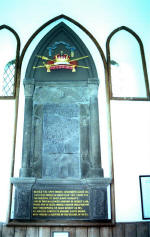 |
Kinkell Church
Two miles south of Inverurie, 38 NJ 785 190
The ruins of a 16th century parish church, with fine sacrament house dated 1524, and
the grave slab of Gilbert de Greenlaw, killed in battle in 1411.
Picture by Duncan Fenton |
 |
Kinnaird Head Lighthouse
On a promontory in Fraserburgh on the A92
Tel: 01346 511022
A fascinating example of fitting new wine into an old bottle. This fine 16th century
castle built for the Fraser family was altered to take the first lighthouse built by the
Commissioners of the Northern Lighthouses in 1787. It is still in working order but has
now been replaced by a small unmanned light nearby. The lighthouse remains much as it was
left by the last lighthouse crew. managed by the Kinnaird Head Trust.
Open all year seven days a week.
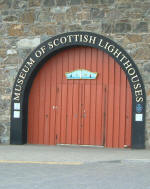
 |
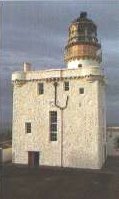
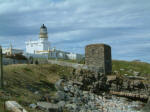 |
Loanhead Stone Circle
Near Daviot, five miles north west of Inverurie, 38 NJ 747 288
The best known of a group of recumbent stone circles, enclosing a ring cairn. Beside
it is a small burial enclosure. From 4,000 to 4,500 years old.
|
 |
Maggie’s Hoosie
No. 26 Shore Street, Inverallochy
built around 1750 was opened to the public. Maggie’s Hoosie is
a typical ‘But and Ben’ fisher cottage. The cottage has since been fully
restored by the ‘Maggie’s Hoose Prevention Trust’ and is open to the public
currently – June to September, Monday to Thursday 2pm to 4pm, or by
appointment. When originally built this house would have probably had a turf
or thatched roof, not the pan tiled roof we see today. The house is a
wonderful example of how the fisher folk lived in the 19th
century. Maggie Duthie (1867 to 1950) lived here all her life, even when
she died there was
still no electricity, lighting, or heating in the house, up to her death she
still used paraffin lamps, open fires, and an antiquated cooking range. In
1950, the house did not even have running water; Maggie still used the well
across the road, which had been modernised to include a pump.
But – The best or parlour room. Ben – the main living
room. (Text
from Fraserburgh Through the Years by Stanley Bruce 2010). |

Picture from Stan Bruce |
Maiden Stone
Near Chapel of Garioch, four and a half miles north west of Inverurie, 38
NJ 703 247
A Pictish cross-slab of 9th century date, it bears on one side a Celtic cross and, on
the other, a variety of Pictish symbols.
Picture by Duncan Fenton |
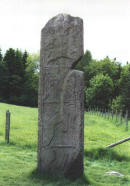 |
Memsie Cairn
Near Rathen, three and a half miles south of Fraserburgh, 30 NJ 976 620
A large stone-built cairn, possibly of Bronze Age date, but enlarged during field
clearance during the last two centuries. |
_small.jpg) |
Mortlach Church Dufftown
Mortlach Kirk stands on the outskirts of
Dufftown in Moray and is one of the earliest Christian Kirks in Grampain.
According to legend a monastery was founded here circa 566 by 'St. Moluag of
Bangor', however the current church only dates back to the 13th century.
There are several ancient graves in the cemetery and there is a watch-house
at the rear of the church where a man would have stayed-in to deter
grave-robbers. Two Pictish stones are to be seen here and these are: 'The
Battle Stone' which is 1.8m high and is situated on a path in the lowest
graveyard extension. It is elaborately carved with a large relief cross,
two fish, and a grotesque beast on one side; and on the other side the
incised forms of a bird, a serpent, an ox skull, and a horseman and dog.
The second stone, thought to be of an earlier date is located in the
vestibule of the church it is incised with a Pictish beast and a unique
curved symbol which may depict an early type of brooch. Grid ref: NJ
324392.
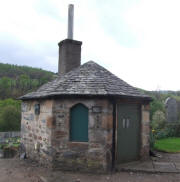 |
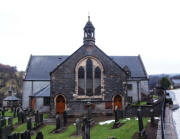
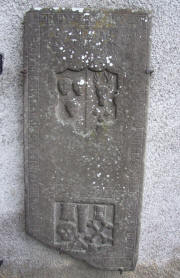 |
Peel Ring of Lumphanan
Half a mile south west of Lumphanan, 37 NJ 576 036
A flat top
motte or mound, one of Grampian's earliest medieval earthworks. Built by
the Durward family in the 13th century consists of a 9m high flat topped
mound 36.6m x 45.7m which is encircled by a ditch or moat. A Manor house
known as Ha'ton House was built here in 1487 by Thomas Charteris of
Kinfauns in Perthshire and was occupied as late as 1782. Macbeth is
reputed to have been slain here in 1057 after the battle of Dunsinane
by Malcolm Canmore son of King Duncan I. Macbeth's well can be seen
nearby at the parish church at burnside. Macbeth's cairn where Macbeth
was buried can be seen north of the village at Perk Hill. In the 19th
century locals used to use the pond here for curling. (Stan Bruce Oct
2005).
|
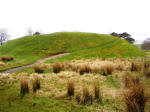 |
Peterhead
Library
Also
houses the Arbuthnot Museum, this building was opened in 1892 and was funded
by Andrew Carnegie, who was the richest man in the world at the time. Entry
to the museum is free and there are several interesting exhibits regarding
the fishing, whaling and the peterhead prison. |
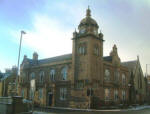 |
Picardy Symbol Stone
Near Mireton, Insch, 29 NJ 609 302
One of the oldest, simplest Pictish symbol stones, possibly of 7th century date.
Picture by Duncan Fenton |
 |
Pitmedden House
and Gardens
Situated one mile west of Pitmedden
village and maintained by the National Trust for Scotland since 1952. The
five acre garden was created by Sir Alexander Seton, Lord Pitmedden and his
wife Dame Margaret Lauder in the late 17th century (1675). The
grounds also contain a visitor centre, a nature trail, a picnic area, and a
farming museum based around the collection of 19th and 20th
century implements of the late William Cook from Tarves donated to the Trust
in 1978. The present Pitmedden House is a 17th-century
house, remodeled in 1853 and again in 1954. It may also incorporate part of
a much earlier building. The castle has been in many hands over the years
including the Seton’s. (S.Bruce Jan 2008). |

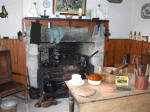
 |
Pitsligo Castle
Sited near Rosehearty is the
former seat of Alexander Lord Forbes of Pitsligo who fought with Bonnie
Prince Charlie at the Battle of Culloden. The castle dates from 1424 with
later additions and is now owned by Pitsligo Castle Trust who took ownership
from the estate of the late Malcolm Forbes of Forbes Magazine, New York.
The castle is currently in a state of disrepair and is considered dangerous.
http://www.pitsligo-castle.org.uk/ |
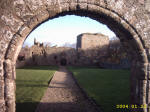 |
Pitullie Castle
A seat of the Fraser's lies within view of
Pitsligo castle, this ruin was built in the 16th century and was abandoned
in 1850. |
_small.jpg) |
|
Rodney’s Stone / Rodney’s
Cross
This is a 2m high by 1m wide approx. Class 2 pictish symbol stone which
was most likely carved in the 8th or 9th century. The stone now located near
the entrance to the Brodie Estate was relocated here in the 1830’s. It was
discovered in 1781 when the foundations for the nearby Dyke Parish Church
were being dug, and in 1782 erected at Dyke as a memorial to Admiral
Rodney’s victory over the French at the Battle of the Saintes off Dominica
also in 1782. Another explanation for the name is that the stone was dug up
by a local gravedigger known as ‘Rotteny’. Prior to this (sometime after
1560) it was used as a recumbent gravestone in Dyke Kirkyard. During its
time as a gravestone it had the initials ‘AC’ and ‘KB’ added, these are
thought to be the initials of a husband and wife who were post 1560 buried
under the stone. It is said to have been brought to Dyke Kirkyard from the
nearby settlement of Moy. There is a lost chapel dedicated to St. Ninian
which once stood in an area of shifting sands near the mouth of the River
Findhorn. Pictish letters or ogham can be seen on the three visible edges of
the stone, these are said to be the longest Ogham inscription in Scotland.
One word has been translated as ‘Eddarrnonn’ perhaps referring to Saint
Ethernan or to the patron who erected the stone. The stone is a scheduled
ancient monument. Stan Bruce 4th April 2016. |
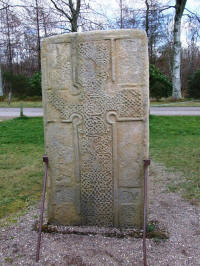
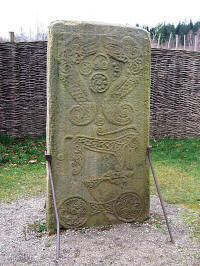 |
| Slains Castle,
New – New Slains Castle sited one
mile north of Cruden Bay was built by Francis Hay the 9th Earl of
Errol in 1597 to replace Old Slains Castle. It was altered in 1664, 1707
and 1837, and abandoned in 1925 to 1926. Slains is one of Scotland’s most
famous castles due to its association with Bram Stoker the author of
Dracula. Stoker started to write his novel Dracula while staying in Cruden
Bay in 1895. There is a car park at the side of the main road however there
is a bit of a walk to get to the castle. Grid ref NK102362. (S. Bruce Jan
2008). |
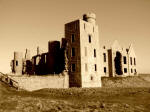 |
|
Slains Castle
– Referred to locally as ‘Old Slains’. Old Slains Castle is located four
miles south of Cruden Bay and was originally a seat of the Comyn Earl of
Buchan, the castle was given to William Errol by Robert the Bruce after the
Comyn’s were defeated at the Battle of Barra and the Battle of Aikey in
1308. The castle was destroyed by King James IV in 1590’s after the ninth
Earl of Errol took part in an unsuccessful catholic rebellion against the
crown. The Earl fled to France and only returned in 1597 after being
pardoned by the king. On his return he built New Slains to the north of
Cruden Bay. All that remains of the castle is basically one wall. Although
this castle stands at the coast it is very difficult to find and we
recommend if you want to visit it you take with you an ordnance survey map -
Grid ref NK053300. (S. Bruce Jan 2008). |
 |
St Drostan’s Church, Baptismal Font and Well,
New Aberdour
(Situated
about half way between Banff and Fraserburgh).
Some time
after 300 BC it is believed that there was a Druid settlement in Aberdour,
where they held their annual festivals and ceremonies. St Columba and his
nephew St Drostan landed here in the 8th century, and parts of St
Drostan’s church are reputedly the oldest in Scotland. The current church
was built in the 16th century alongside the earlier church (date
unknown). Situated in the church is a stone Hexagonal Baptismal Font which
is also thought to be of an earlier date than the current church. In the
churchyard the oldest legible inscription is 1433 on a tombstone of one of
the Bairds of Auchmedden. St Drostan’s well is situated near the beach, its
pure spring water was used by St Drostan to baptise local people and was
famous for giving miracle cures. It is now considered unfit for human
consumption but is regularly used by many a visiting dog. The view of the
cliffs and the caves is brilliant and well worth a visit.
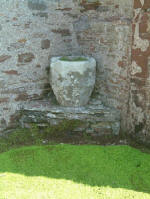
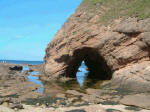
|

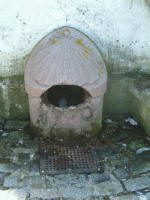
 |
St Machar's Cathedral Transepts
In Old Aberdeen
The nave and towers of the Cathedral remain in use as a church, and the ruined
transepts are in care. In the south transept is the fine tomb of Bishop Dunbar (1514-32).
The nearby
bridge 'Brig o' Balgownie' over the Don in Old Aberdeen was built under the
instruction of Robert the Bruce in 1320.
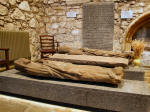
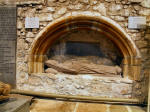
Inside the Cathedral showing heraldic shields
A 3.9Mb .pdf file with lots of pictures
|
 |
St Mary's Kirk, Auchindoir
Near Lumsden, three miles north of Kildrummy, 37 NJ 477 244
One of the finest medieval parish churches in Scotland, roofless, but otherwise
entire. There is a rich early Romanesque doorway and a beautiful early 14th
century
sacrament house, comparable with those as Deskford and Kinkell.
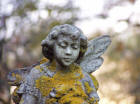
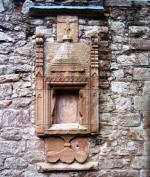
St Mary’s first existed as a
parish church in the 13th century. What we see today is the ruin
of a church extensively altered in the 17th century. Key
features of this church which have managed to survive from mediaeval times
are the richly detailed round arched south door, the sacrament house
designed to hold the consecrated host, and a simple piscine (A basin used to
wash sacred vessels). My favourite item in the churchyard is a small angel
statue on the headstone of a previous minister’s wife. This church was in
use until 1810 when a replacement was built. (Stan Bruce Nov 2005).
|
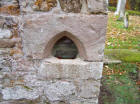
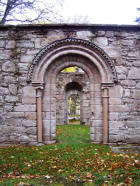
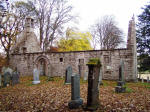 |
St Mary's Church yard
In the old part of Banff. The recently restored
16th century vaulted Aisle in St Mary's historic medieval church yard in
Banff (Church was demolished in 1830).
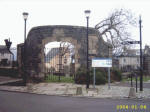 |
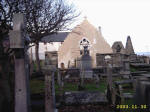 |
St Medden's
Kirk, Aberdeenshire
Mediaeval kirk situated within a
cluster of trees on the north side of the Don river. The kirk is roofless
and not in very good order. Inside a sacrament house van be seen and in the
small graveyard two interesting stones. One an upright headstone shows a
maltese cross and a dagger, the other which is lying horizontal shows
incised circles with crosses inside perhaps of Pictish origin. Grid ref
NJ873156 (S. Bruce Nov 2007).
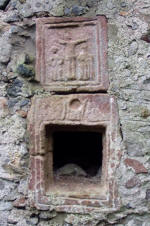
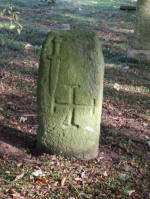 |
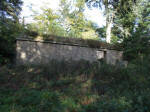
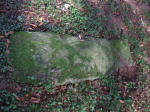
 |
St Peter's Kirk and Parish Cross,
Duffus
Duffus Churchyard
The roofless remains of the kirk include the base of a 14th century westewrn tower, a
16th century vaulted porch and sopme interesting tombstones. The cross is of 14th century
date.
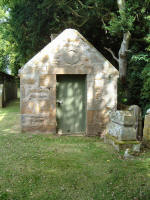
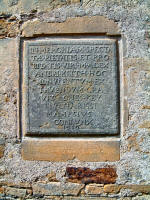
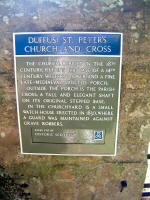
|
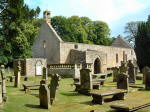
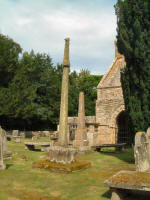
|
St Peter's Kirk,
Fyvie
The present church dates from 1808AD,
however the first St Peter's church was referrred to as far back as 1178AD.
There are two bells in the bellcote one dated 1609 and the other 1809.
Click here to see
more pictures and additional information |
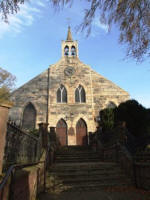 |
Spynie Palace
2m N of Elgin off the A941.
Tel: 01343 546358
Opening to visitors this summer, Spynie Palace was the residence of the bishops of Moray
from the 14th century to 1686. The site is dominated by the massive tower built by Bishop
David Stewart and affords spectacular views across Spynie Loch.
Winter: open weekends only. |
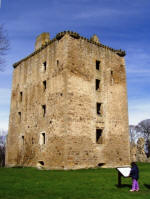 |
Sueno's Stone
At the east end of Forres, 27 NJ 046 595
The most remarkable sculptured monument in Britain, probably a cenotaph, standing
over 20 feet high and dating to the end of the first millennium AD. Covered by a
protective glass enclosure.Picture by
Duncan Fenton |
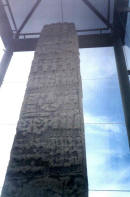 |
Tarves Medieval Tomb
In Tarves kirkyard, 15 miles north north west of Aberdeen
A fine altar-tomb of William Forbes, the laird who enlarged Tolquhon Castle. The
carving is a remarkable survival.
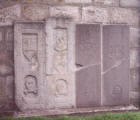 |
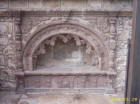
|
|
Temple of Venus
Standing high
on top of Doune hill between Banff and Macduff, built by the Earl of Fife
in the 1700's. From here you get brilliant views of Banff, Banff Bay the
Deveron Bridge and Duff House. The seven arch Deveron bridge was built in
1799 for the 2nd Earl of Fife and was designed by the well known architect
John Smeaton.
|

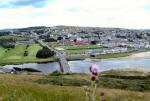 |
The Plainstones in Low St, Banff
Here we find several interesting
historic pieces:
The market cross dating from the 16th Century.
The Biggar fountain dated 1878.
The Stuart Royal Coat of Arms dated 1634. Adjacent to the coat of arms is a
panel dated 1628 which may have been part of the original base of the market
cross, the market cross has been moved twice and originally stood
approximately where the Biggar fountain now stands, (Also stood above the
Sandyhills doo-cot for a while).
Sebastopol Cannon from the Crimean war (1855). A similar cannon was taken
form Sebastopol and the cascabels are used to make the Victoria Cross.
Town House built 1797 and
the Steeple was built 1794.
The Carmelite Monastery once
stood on the ground here.
The Tolbooth
hotel built in 1801 is on the site where James McPherson the Freebooter in
1700 was locked up before being hanged, the clock in Banff was reputedly put
forward one hour to ensure he was hanged because a reprive was on it's way.
He may have been hanged either on the gallowhill or perhaps on the hill
where Sandyhills doo-cot is located.
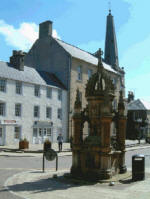
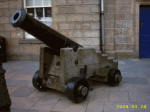
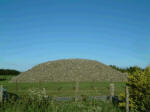 |
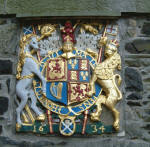

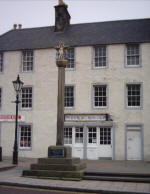 |
|
The
Red Well
1.5 miles
west of Banff on the coast, a chalybeate spring dating back to roman
times. The well is reputedly haunted by an old woman who is believed to
be a ghost of an old woman who was once the caretaker of the well.
|
 |
Tolquhon Castle
15m N of Aberdeen on the A920.
Tel: 01651 851286.
Noted for its highly ornamented gatehouse and pleasance, Tolquhon was built for the Forbes
family. The early 15th-century tower was enlarged between 1584 and 1589 with a large
mansion round a courtyard.
Winter: open weekends only. |
 |
Tomnaverie Stone Circle
Near Mill of Water Coull, about three miles north west of Aboyne, 37 NJ 486 034
Recumbent
stone circle around 4,000 years old recently restored.and a new car park
has been made by Historic Scotland. (Stan Bruce Oct 2005).
|
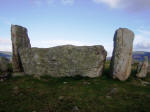
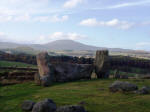 |
Troup Head
10 mile east of Banff. Clinging to the cliffs you can see Guillemots,
Razorbills and all types of seagulls, but the most amazing site is the
colony of Gannets, the only colony in mainland Scotland, (the only other
place they can be seen are on St Kilda and Bass Rock). You can also see
puffins swimming in the water or flying past, one of the secret places of
'The Graet North East Corner' accessible from a farm track or from one of
the pleasure craft which operate from Banff or Macduff. 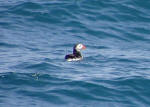 |
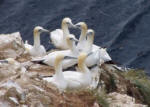
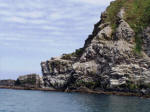 |
Hallforest Castle
4 miles south of Inverurie, north of B994 NJ 777154
14th C keep. Built as a hunting lodge for Robert The Bruce.
Photo by Duncan Fenton |
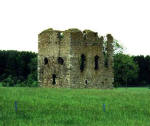 |
| War
Memorials
|
|

